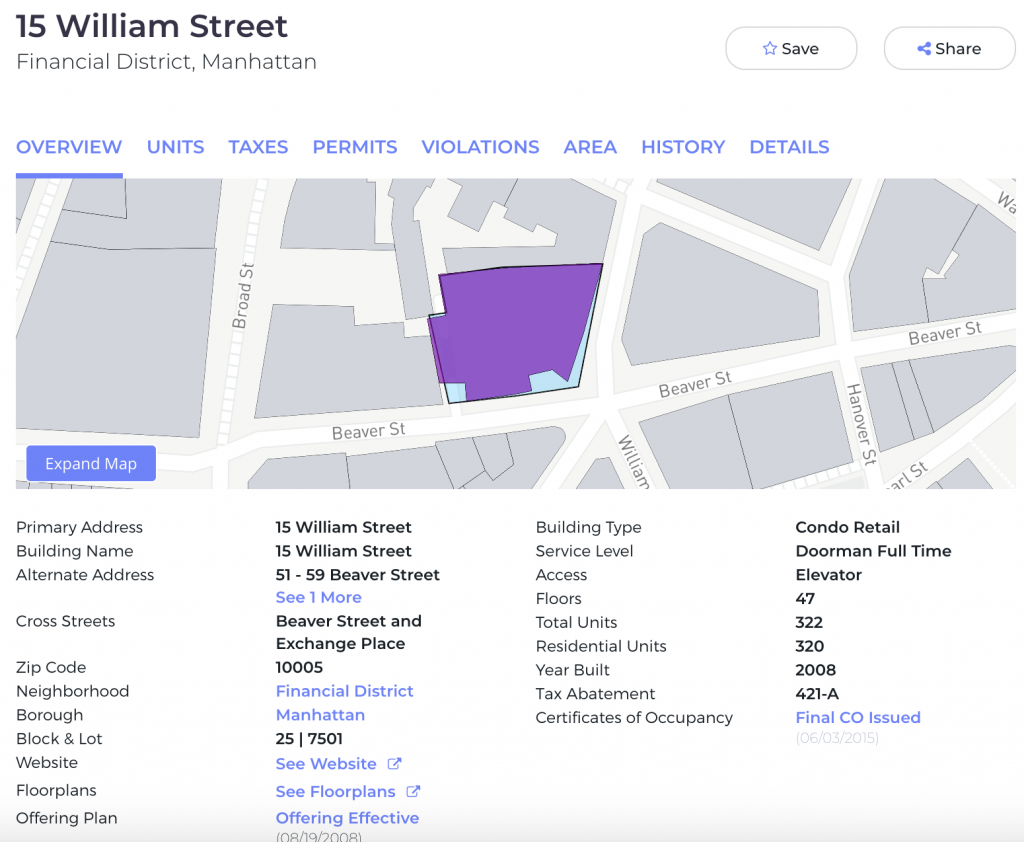In NYC real estate, BBL stands for borough, block, and lot.
This 10-digit number identifies each individual piece of land in NYC. It is also universal, so it makes tracking buildings across databases easier.
The Department of Finance allocates BBLs for tax purposes for all residential and commercial properties. The Department of Buildings issues another identifier, the Building Identification Number.

Check out Marketproof Pipeline for the most information anywhere on the NYC residential and commercial construction pipeline.
What is a block? What’s a lot?
A block is what it sounds like — a group of contiguous lots bound by streets in the same way a city block is. A lot is an individual piece of land within a block that is intended to be sold or conveyed in its entirety to a buyer.
However, there are exceptions to what constitutes a block. Sometimes, a block accounts for two or three city blocks. Two particular exceptions are Battery Park City and Brooklyn Navy Yard. Both are a single block.
The US and Canada use the block and lot survey system to locate and identify land. It is usually used in densely populated areas such as towns and cities. It is also known as the recorded plat survey system or the recorded map survey system.
Check out Marketproof New Development for the most information anywhere on NYC condos.
How do you determine a BBL?
The first digit represents the borough: 1 for Manhattan, 2 for the Bronx, 3 for Brooklyn, 4 for Queens, and 5 for Staten Island.
The next five represent the block. In many cases, the block number is fewer than five digits (1129, for example). In that case, you add zeroes to the front of the five block digits (01129). The same goes for the lot, which accounts for the four digits at the end.
So, let’s say a building is in Brooklyn, its block number is 1129, and its lot number is 7501. Its BBL would be 3011297501.
Where do I find a BBL?
Marketproof allows you to search for specific buildings, including both residential and commercial buildings.
Let’s say you want to find the BBL of the condo building in the photo above, One Wall Street. Type that into the Marketproof search bar, and it will take you to the One Wall Street building page. Immediately, on the Overview tab for the building, you will see the block and lot: 23 | 7501. 23 is the block. 7501 is the lot. (The lot for condo buildings almost always starts with 75.)
That means you can determine the BBL. The first digit is 1 for Manhattan. The next five digits, for the block, are 00023. The final four, for the lot, are 7501. Therefore, the BBL for 1 Wall Street is 1000237501.
Where do I find the BBL for a specific condo unit?
This is where things get a bit more complicated. If you’re considering a unit in a new development, you will want to consider subscribing to Marketproof New Development. Marketproof New Development is the only site where you will find information about all the units in new condos, such as One Wall Street.
Additionally, Marketproof New Development shows you the details of past sales as well as a new building’s shadow inventory, or the available apartments the developer is not currently listing.
If the building is older, you will find the block and lot for most individual units right on the main Marketproof site. Let’s take 15 William Street, a 2008 building in the Financial District, as an example. You’ll see on the building page that the block and lot are 25 and 7501. That makes the BBL 1000257501.

If you want to determine the BBL of a specific unit, click on the Units tab. There, you should be able to find any specific unit in the building.

Let’s say we want to determine the BBL of Unit 4D. Click on that unit, and you’ll see the block and lot: 25 and 1405. Notice that the block is the same as the overall building’s block: 25. The lot is different, identifying this particular unit. The BBL for Unit 4D at 15 William Street is 1000251405.

Why Marketproof is the best place to find your BBL
Marketproof is the optimal place to search for a BBL because you can search the site using any number of building and unit identifiers. This distinguishes Marketproof and makes it more user-friendly than government platforms such as ACRIS. Marketproof’s software collects data from ACRIS and other government sites and optimizes its presentation.
Here are some other reasons you should choose Marketproof when searching for your BBL or block and lot:
- ACRIS does not give you the ability to search by known-as address or alternate addresses. In other words, what people know as the building’s address is often not what’s on file for the Department of Finance. This makes many searches come up empty on ACRIS
- Marketproof provides the ability to search by any address or even building name with autocomplete. This makes your search experience more efficient
- ACRIS does not provide a list of units in a building. In addition, unit number search is also very hit or miss: You must know exactly what you’re looking for. Marketproof makes this easy by providing you with a list of units, so you can easily find what you’re looking for
Marketproof
With Marketproof, you can search for BBLs for all residential and commercial properties in NYC. Start here.
Top photo courtesy of 1 Wall Street.



